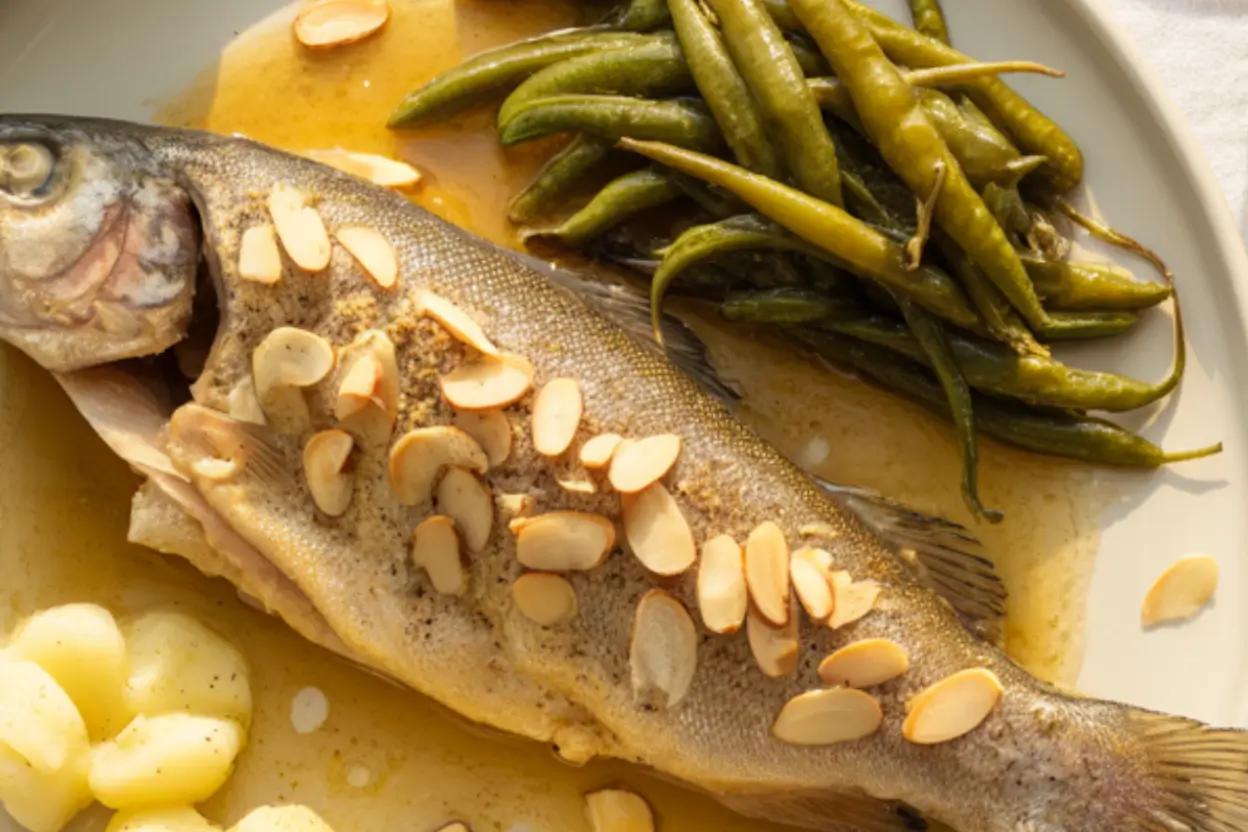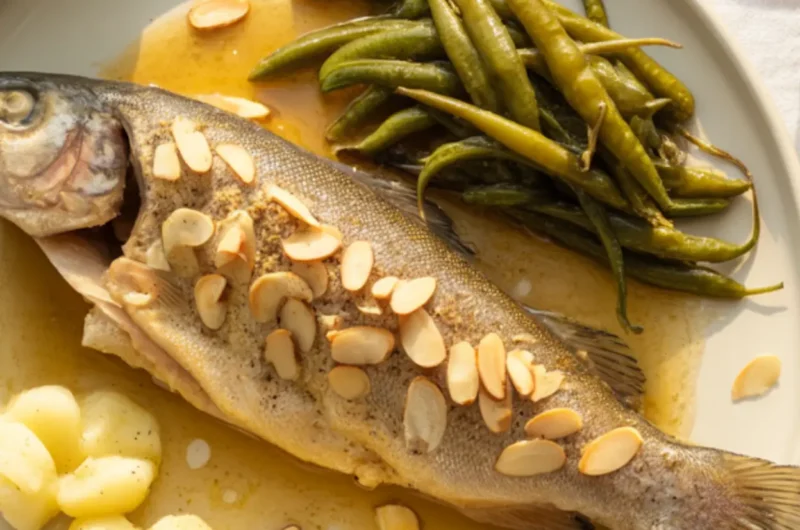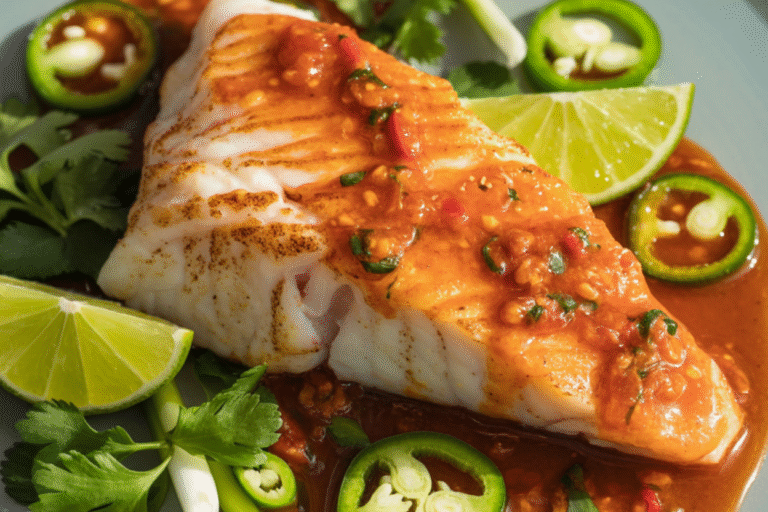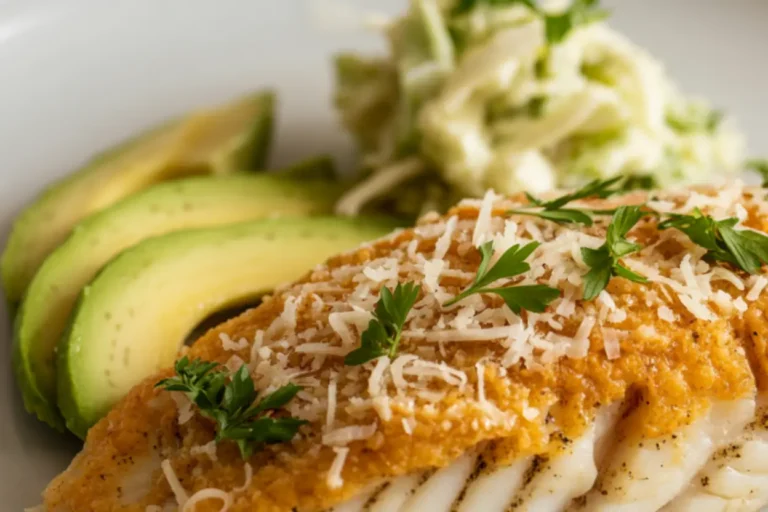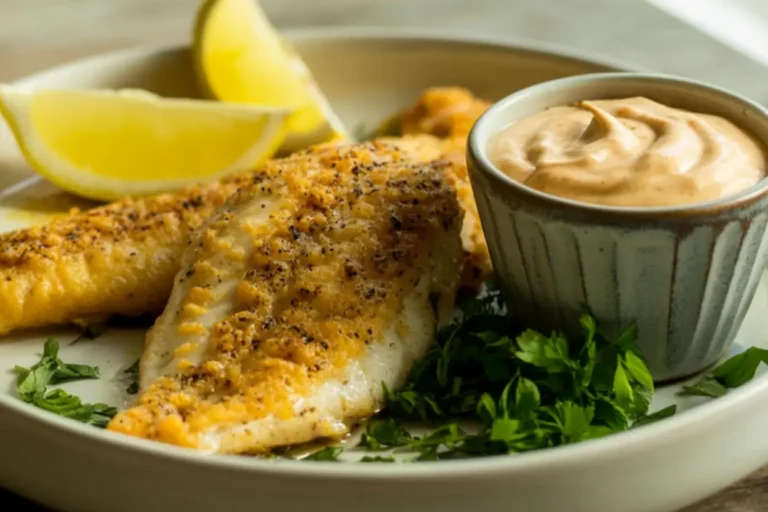Trout Amandine: 7 Steps to a Classic French Favorite
Table of Contents
There’s something magical about classic French cuisine—the way it transforms simple ingredients into elegant, unforgettable dishes. Among these timeless recipes, Trout Amandine stands out as perhaps the perfect representation of this culinary philosophy. After years of perfecting this dish in my own kitchen and studying under French-trained chefs, I’m excited to share my definitive guide to creating restaurant-quality Trout Amandine at home.
Thank you for reading this post, don't forget to subscribe!Whether you’re looking to impress dinner guests or simply elevate your weeknight cooking, this recipe delivers a perfect balance of delicate fish, nutty brown butter, and crunchy almonds. Despite its sophisticated reputation, Trout Amandine is remarkably straightforward to prepare—taking less than 30 minutes from start to finish while creating a dish that looks and tastes like it came from a high-end French bistro.
How to Make Trout Amandine
Quick Overview
Trout Amandine exemplifies everything wonderful about classic French cuisine—it’s elegant yet approachable, sophisticated yet simple. This dish features delicate trout fillets cooked to perfection, with crispy skin and tender, flaky flesh. What makes it truly special is the signature sauce: a nutty brown butter sauce (beurre noisette) that’s punctuated with the delightful crunch of toasted almonds and brightened with fresh lemon and herbs.
Despite its impressive presentation and complex flavor profile, Trout Amandine is surprisingly straightforward to prepare. The entire dish comes together in about 25 minutes using just one pan (plus a small one for the sauce). It’s the perfect example of how thoughtful technique and quality ingredients can create something far greater than the sum of its parts.
The beauty of this recipe lies in its contrasts—the crispy exterior of the fish against the tender interior, the rich nuttiness of the brown butter against the bright acidity of lemon, and the soft texture of the trout against the satisfying crunch of toasted almonds. These harmonious contrasts create a multi-dimensional dish that feels indulgent yet light, making it suitable for everything from casual weeknight dinners to special occasions.
The Ingredients I Use to Bring My Trout Amandine to Life
For the Trout:
- 4 rainbow trout fillets (6-8 ounces each), skin-on and deboned
- ½ teaspoon kosher salt
- ¼ teaspoon freshly ground black pepper
- ¼ teaspoon garlic powder
- 2 tablespoons all-purpose flour
- 2 tablespoons neutral oil (such as grapeseed or canola)
For the Amandine Sauce:
- 6 tablespoons unsalted butter
- ⅔ cup sliced almonds
- 1 medium shallot, finely minced (about 2 tablespoons)
- 2 tablespoons fresh lemon juice
- 2 teaspoons lemon zest
- 2 tablespoons fresh parsley, finely chopped
- ¼ teaspoon kosher salt
- ⅛ teaspoon white pepper (or black pepper)
For Garnish:
- 1 lemon, cut into wedges
- Additional fresh parsley leaves
- Optional: 1 tablespoon capers, rinsed and drained
Step-by-Step Instructions
Step 1: Prepare the Trout
- Begin by patting the trout fillets completely dry with paper towels. This step is key to getting beautifully crisp skin and that perfect golden-brown finish.
- Inspect each fillet carefully for any remaining pin bones. Use fish tweezers or clean needle-nose pliers to remove any bones you find by firmly gripping each bone and pulling it out at the same angle it’s embedded in the flesh.
- Once the fillets are dry and bone-free, season both sides with the kosher salt, black pepper, and garlic powder, distributing the seasonings evenly.
- Sprinkle the all-purpose flour onto a large plate. Gently press each fillet, flesh side only, into the flour to create a thin, even coating. Shake off any excess flour and set the fillets aside on a clean plate. The skin side should remain unfloured.
- Allow the seasoned and floured fillets to rest at room temperature for 5-7 minutes while you begin preparing the sauce components. This brief rest helps the seasonings adhere and takes the chill off the fish for more even cooking.
Step 2: Toast the Almonds
- Heat a large, heavy-bottomed skillet (preferably non-stick or well-seasoned cast iron) over medium heat. Do not add any oil yet.
- Add the sliced almonds to the dry skillet and toast them, stirring frequently, until they’re fragrant and golden brown, about 3-4 minutes. Watch them carefully, as nuts can go from perfectly toasted to burnt very quickly.
- As soon as the almonds reach a light golden color, transfer them to a small bowl to prevent further browning. Set aside for the sauce.
- Wipe out the skillet with a paper towel to remove any almond bits, as they might burn during the fish cooking process.
Step 3: Cook the Trout Fillets
- Return the clean skillet to the stove and increase the heat to medium-high. Add the neutral oil and heat until it’s shimmering but not smoking.
- Carefully place the trout fillets into the hot pan, skin-side down. Use a fish spatula or the back of a spoon to gently press each fillet flat for the first 10-15 seconds to prevent curling.
- Cook the fillets skin-side down without moving them for 3-4 minutes, until the skin is crispy and golden and the flesh has turned opaque about halfway up the sides.
- Gently flip the fillets with a fish spatula and cook for another 1–2 minutes on the flesh side, just until the fish is fully cooked. The flesh should be tender, flake easily with a fork, and stay moist.
- Transfer the cooked fillets to a warm plate, skin-side up to maintain crispness, and tent loosely with foil while you prepare the sauce.
Step 4: Prepare the Brown Butter
- Reduce the heat under the skillet to medium-low. Wipe out any burnt bits with a paper towel, but leave any flavorful brown residue.
- Add the butter to the skillet and allow it to melt completely, swirling occasionally.
- Watch the butter carefully as it begins to foam—this is water evaporating from the butter. The color will progress from yellow to golden to amber.
- Continue cooking until the butter turns a nutty brown color and emits a toasty, nutty aroma, about 3-4 minutes total. You’ll see little brown specks begin to form at the bottom of the pan—these are milk solids caramelizing and are crucial for the sauce’s flavor.
- Once you achieve a medium amber color (similar to maple syrup), immediately proceed to the next step to prevent the butter from burning.
Step 5: Complete the Amandine Sauce
- Add the minced shallot to the brown butter and sauté for about 30 seconds until fragrant but not browned.
- Return the toasted almonds to the skillet, stirring to coat them in the brown butter.
- Carefully add the lemon juice (it may spatter), lemon zest, salt, and white pepper to the skillet, stirring to combine. The acid from the lemon juice will immediately halt the butter’s cooking process.
- Remove the pan from the heat and stir in the chopped parsley, reserving a small amount for garnish.
- Taste the sauce and adjust seasoning if necessary, keeping in mind that the fish is already seasoned.
Step 6: Assemble the Dish
- Place each trout fillet on an individual serving plate or arrange them on a serving platter.
- Spoon the hot amandine sauce generously over each fillet, making sure to distribute the almonds evenly.
- If using capers, sprinkle them over the top of the fish now.
- Garnish with the reserved fresh parsley and place lemon wedges alongside the fillets.
- Serve immediately while the sauce is still warm and the fish is at its peak texture.
Step 7: Serve with Perfect Timing
- Once the sauce is spooned over the fish, serve the dish immediately—Trout Amandine is at its absolute best when the fish is still warm and the sauce is freshly made.
- If serving family-style, transfer everything to a pre-warmed serving platter to help maintain temperature.
- Encourage diners to squeeze the fresh lemon wedges over their portions just before eating for that perfect burst of citrus brightness.
- Have additional napkins available—this is an elegant dish, but the combination of butter sauce and flaky fish can be a bit messy to eat.
- Pour your selected accompanying beverages and enjoy while hot!
What to Serve Trout Amandine With
Trout Amandine pairs beautifully with a variety of side dishes that complement its delicate flavors without overwhelming them:
Classic French Accompaniments:
- Haricots Verts (thin French green beans) quickly blanched and tossed with butter and almonds
- Pommes de Terre à la Vapeur (steamed new potatoes with herbs)
- Simple green salad with light lemon vinaigrette
- Crusty French baguette for sopping up the delicious sauce
- Herbed rice pilaf with a touch of lemon
Seasonal Vegetable Options:
- Spring: Asparagus spears with lemon butter
- Summer: Quick-sautéed zucchini and yellow squash
- Fall: Roasted Brussels sprouts with a touch of maple
- Winter: Braised fennel with herbs
Grain Accompaniments:
- Wild rice blend with herbs
- Farro with roasted vegetables
- Quinoa with lemon and herbs
- Simple couscous with a touch of olive oil and parsley
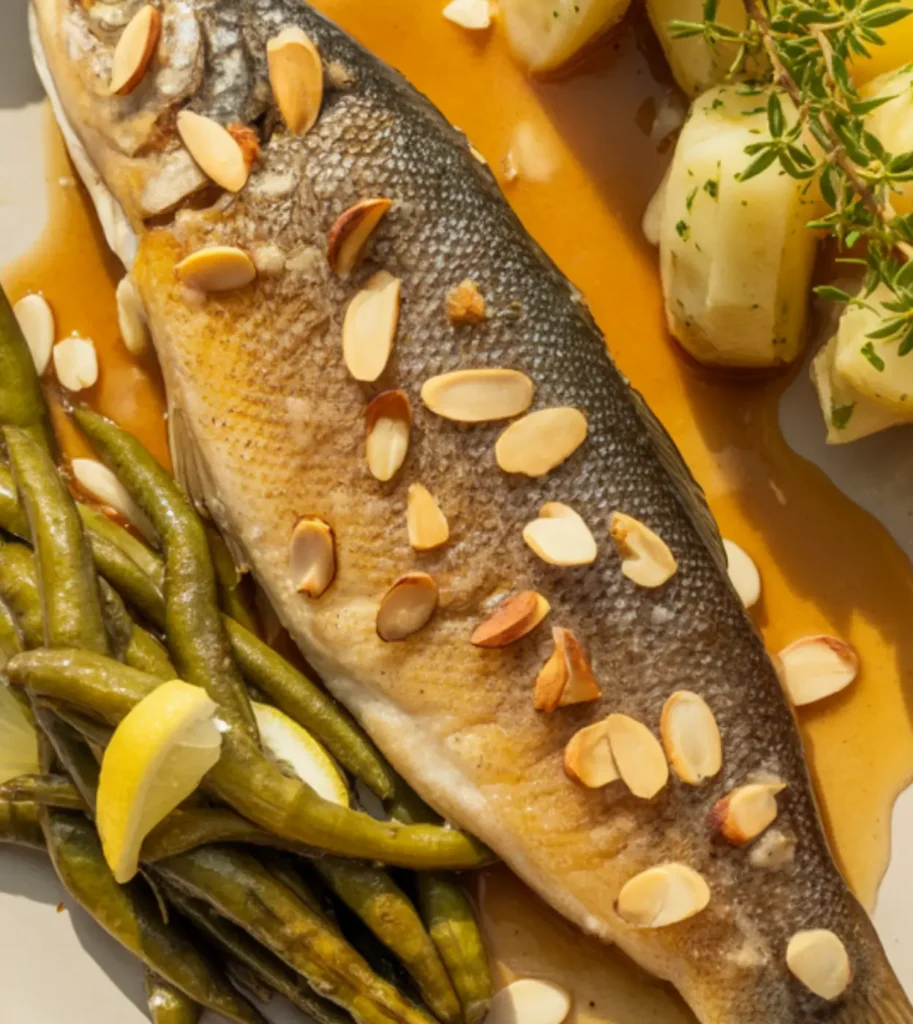
Top Tips for Perfecting Trout Amandine
Tip #1: Master the Art of Fish Selection and Preparation
The foundation of exceptional Trout Amandine begins with the fish itself:
- Selecting the perfect trout: Look for rainbow trout with bright, clear eyes, firm flesh, and a fresh, clean smell. Farm-raised rainbow trout is widely available and sustainably raised, making it an excellent choice for this dish.
- Bone removal technique: Run your fingertips gently along the flesh to feel for pin bones, which typically run down the center of the fillet. Remove them by pulling in the same direction they’re pointing using fish tweezers.
- The critical drying step: Thoroughly patting the fish dry with paper towels is non-negotiable. Moisture is the enemy of crispy skin and proper browning—take your time with this step.
- Room temperature matters: Allow the seasoned fish to rest at room temperature for 5-10 minutes before cooking. If the fish is too cold straight from the fridge, it can cook unevenly and is more likely to stick to the pan. Let it sit at room temperature for a bit before cooking.
- Skin-on advantage: The skin provides a natural protective layer, helping the delicate flesh remain moist during cooking while adding wonderful textural contrast.
Tip #2: Perfect the Brown Butter Technique
Brown butter (beurre noisette) is the heart and soul of Trout Amandine:
- Pan selection: Use a light-colored pan if possible when browning butter, as it allows you to more accurately monitor the color changes.
- The color progression: Watch for the distinct stages—melted, foamy, golden, and finally nutty brown with toasty milk solids. The transition from golden to brown happens quickly, so never walk away.
- Aroma indicators: Your nose is as important as your eyes; the butter will emit a distinctly nutty, almost toasty aroma when it’s perfectly browned.
- Temperature control: Lower the heat if the butter is darkening too quickly. Low and slow is far better than hot and rushed when it comes to brown butter.
- The lemon juice pause button: Adding acidic lemon juice immediately halts the cooking process, preventing the butter from crossing the line from brown to burnt.
Tip #3: Achieve the Perfect Cook on Your Trout
Properly cooked fish is the difference between good and great Trout Amandine:
- The hot pan test: Before adding oil, make sure your pan is properly heated by flicking a few drops of water onto the surface—they should dance and evaporate immediately.
- The pressing technique: Gently pressing the fillets flat for the first few seconds prevents curling and ensures even cooking.
- Resisting the flip urge: Patience is crucial—the fish will naturally release from the pan when the skin is properly crisp. If you feel resistance, wait longer.
- The 70/30 rule: Spend about 70% of your total cooking time on the skin side, and just 30% on the flesh side. This ratio creates perfectly crispy skin while keeping the delicate flesh moist.
- Visual doneness cues: Look for opaque flesh and an internal temperature of about 145°F (63°C). The fish should flake easily but still appear moist—overcooking will quickly dry out trout.
Tip #4: Perfect Your Almond Handling
The almonds provide crucial texture and flavor in this classic dish:
- Slice selection: Pre-sliced almonds are convenient but often too thin. If possible, purchase whole almonds and slice them yourself for a more substantial texture, or look for “artisanal” sliced almonds which tend to be thicker.
- The dry toasting method: Always toast almonds in a dry pan before adding other ingredients. This develops their flavor fully and ensures they retain their crunch when added to the sauce.
- Visual cues for perfect toasting: Look for light golden color and an aromatic nutty smell. Remember that nuts continue to cook slightly from residual heat after removal from the pan.
- Alternatives for depth: For a deeper flavor profile, try substituting a portion of the almonds with toasted pine nuts or hazelnuts.
- Emergency rescue: If your almonds start to burn, immediately transfer them to a cool plate (not a bowl, which traps heat). Discard any that are too dark, as they’ll impart bitterness.
Tip #5: Balance Flavors Like a Professional
A perfectly balanced sauce makes Trout Amandine truly exceptional:
- The acid balance: The lemon juice should brighten the brown butter without overwhelming it. Start with the suggested amount, then taste and adjust if needed.
- Zest incorporation timing: Add the lemon zest near the end of cooking to keep its bright oils and fresh aroma intact, since long heat can cause them to fade.
- Herb freshness: Fresh parsley is strongly preferred over dried for both flavor and color. If you must substitute, use dried parsley in much smaller amounts (about 2 teaspoons).
- Consider capers: For an additional burst of briny flavor that cuts through the richness, consider adding rinsed capers to the sauce just before serving.
- Final seasoning: Always taste your sauce before pouring it over the fish, but remember that the fish is already seasoned, so adjust with care.
Tip #6: Master the Art of Timing
Proper timing elevates Trout Amandine from good to exceptional:
- Component preparation: Have all ingredients measured and ready before beginning to cook (mise en place), as the process moves quickly once started.
- Fish rest period: Allow cooked fish to rest for 1-2 minutes before saucing—this brief pause helps the proteins relax for a more tender final texture.
- Sauce speed: Once your butter begins to brown, work quickly through the remaining sauce steps to prevent burning.
- Serving immediacy: Plan your meal timing so that sides are ready just as you’re completing the sauce. Trout Amandine is at its peak within minutes of preparation.
- Plate warming: For restaurant-quality presentation, warm your serving plates in a low oven (200°F/95°C) for 5 minutes before plating. This simple step keeps everything at the proper temperature longer.
Tip #7: Respond to Common Challenges
Even experienced cooks encounter issues—here’s how to handle them:
- Skin sticking solution: If the skin sticks despite proper heating, the pan was likely not hot enough initially. Next time, test with a water droplet before adding oil.
- Butter burning rescue: If your butter darkens too quickly, immediately add a tablespoon of cool butter to lower the temperature and dilute the browned milk solids.
- Flesh breaking fix: If your fish begins to break apart when flipping, it’s likely overcooked. Use a fish spatula and perhaps a supporting spoon to carefully turn intact pieces.
- Sauce separation solution: If your sauce looks separated or “broken,” remove from heat and whisk in 1-2 teaspoons of cold water to re-emulsify.
- Texture correction: If your sauce becomes too thick, thin it with a small amount of warm water. If too thin, reduce it slightly over medium-low heat until the desired consistency is reached.
Storing and Reheating Tips
While Trout Amandine is undeniably best when freshly made, proper storage and reheating can help maintain quality when necessary:
Short-Term Storage:
- Separate components when possible. Store cooked fish and sauce separately in airtight containers in the refrigerator.
- Properly stored, the trout will keep for up to 2 days, though quality begins to diminish after the first 24 hours.
- The sauce can be refrigerated for up to 3 days. It will solidify when chilled—this is normal.
Reheating Methods:
- For the Fish:
- Oven method (preferred): Preheat oven to 275°F (135°C). Place fish on a baking sheet and cover loosely with foil. Heat for 10-12 minutes until just warmed through.
- Avoid microwaving if possible, as it can make the fish rubbery and cause the skin to lose its crispness.
- For the Sauce:
- Gently rewarm in a small saucepan over low heat, stirring occasionally.
- Add 1-2 teaspoons of water if needed to reach desired consistency.
- Heat just until the butter is melted and the sauce is warm—not hot—to prevent it from breaking.
- Reassembly:
- Place the warmed fish on a serving plate.
- Spoon the rewarmed sauce over the fish.
- Finish with fresh herbs and a new lemon wedge for optimal flavor.
Not Recommended for Freezing:
- Trout Amandine does not freeze well. The delicate texture of the fish deteriorates significantly, and the sauce tends to separate when frozen and thawed.
- If you must freeze components, the plain cooked trout fillets can be frozen separately for up to 1 month, tightly wrapped. The sauce is not suitable for freezing.
Creative Repurposing:
Rather than trying to recreate the original dish with leftovers, consider these alternatives:
- Trout Salad: Remove the skin from any leftover fish, then flake the meat and toss it with fresh greens, the remaining sauce (let it come to room temperature), and a mix of fresh vegetables for a flavorful, refreshing salad.
- Breakfast Hash: Gently fold flaked trout into breakfast potatoes with bell peppers and onions for a luxurious morning meal.
- Fish Cakes: Combine flaked trout with mashed potatoes, herbs, and an egg, then pan-fry for delicious fish cakes.
- Pasta Enhancement: Toss flaked trout and leftover sauce (rewarmed) with hot pasta and additional fresh herbs for a quick meal.
Quality Assessment:
- Always check leftover fish carefully before reheating. It should maintain its original clean smell—any strong “fishy” odor indicates it has begun to spoil and should be discarded.
- The color should remain relatively unchanged. Significant discoloration is a sign that the fish is no longer at its best.
By implementing these seven detailed steps and incorporating my expert tips, you’ll create a Trout Amandine that honors its French bistro heritage while being entirely achievable in your home kitchen. This elegant yet approachable dish showcases the beautiful simplicity that makes classic French cooking so enduringly popular. The combination of perfectly cooked trout, nutty brown butter, and crunchy almonds creates a harmonious dish that’s far greater than the sum of its parts—proving once again that when quality ingredients are treated with proper technique and respect, truly magical meals result.
Trout Amandine: 7 Steps to a Classic French Favorite
Cuisine: FrenchDifficulty: Easy to Moderate4
servings20
minutes15
minutes350–400
kcalTrout Amandine is a classic French dish that features tender trout fillets pan-fried to a golden crisp and topped with toasted almonds and a buttery lemon sauce. The dish pairs beautifully with simple, seasonal sides such as haricots verts tossed in butter and almonds, steamed new potatoes, or a light green salad with lemon vinaigrette. Its elegance and balance make it a favorite for showcasing fresh fish alongside vibrant, complementary flavors.
Ingredients
Haricots Verts (thin French green beans) quickly blanched and tossed with butter and almonds
Pommes de Terre à la Vapeur (steamed new potatoes with herbs)
Simple green salad with light lemon vinaigrette
Crusty French baguette for sopping up the delicious sauce
Herbed rice pilaf with a touch of lemon
Spring: Asparagus spears with lemon butter
Summer: Quick-sautéed zucchini and yellow squash
Fall: Roasted Brussels sprouts with a touch of maple
Winter: Braised fennel with herbs
Wild rice blend with herbs
Farro with roasted vegetables
Quinoa with lemon and herbs
Simple couscous with a touch of olive oil and parsley
Directions
- Prepare the Trout
Pat the trout fillets dry with paper towels to ensure crispy skin. Remove any pin bones with tweezers, then season both sides evenly with salt, pepper, and garlic powder. Lightly coat the flesh side with flour and let the fillets rest at room temperature for 5–7 minutes to help the seasoning set and promote even cooking. - Toast the Almonds
Heat a dry skillet over medium heat and toast the sliced almonds, stirring frequently until golden and fragrant, about 3–4 minutes. Remove the almonds promptly to prevent burning and set them aside. Wipe out the pan before cooking the fish. - Cook the Trout
Heat oil in the skillet over medium-high heat. Place the trout fillets skin-side down and press gently for 10–15 seconds to prevent curling. Cook without moving for 3–4 minutes until the skin is crisp and golden. Flip the fillets and cook for another 1–2 minutes until just cooked through. Transfer to a warm plate, skin-side up, and tent with foil. - Make the Brown Butter
Reduce the heat to medium-low and melt butter in the skillet, swirling occasionally. Cook until it foams and turns a rich amber color with a nutty aroma, about 3–4 minutes. Watch carefully to avoid burning—the brown specks on the bottom add great flavor. - Finish the Amandine Sauce
Add minced shallot to the brown butter and cook for 30 seconds until fragrant. Stir in toasted almonds, lemon juice, zest, salt, and white pepper. Remove from heat and mix in chopped parsley. Adjust seasoning to taste. - Plate the Dish
Place each trout fillet on plates or a serving platter. Spoon the warm amandine sauce with almonds evenly over the fillets. Garnish with reserved parsley and lemon wedges. Add capers if desired. - Serve Immediately
Serve Trout Amandine right away while the fish is warm and the sauce fresh. Encourage guests to squeeze lemon over their portions for a bright finish. Provide napkins as the buttery sauce can be rich but utterly delicious.
Notes
- Trout Amandine highlights the simplicity and finesse of French cooking—delicate fish enhanced by toasted almonds and a zesty lemon-butter sauce. Choose fresh, high-quality trout for the best flavor, and pair it with seasonal sides like haricots verts or roasted vegetables to complement the dish. The buttery almonds add a delightful crunch and nutty richness that make this dish both comforting and elegant. Don’t forget the crusty baguette—it’s perfect for soaking up the delicious sauce!

